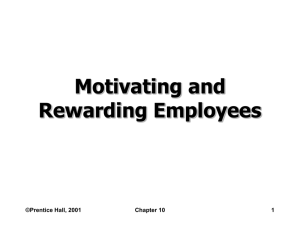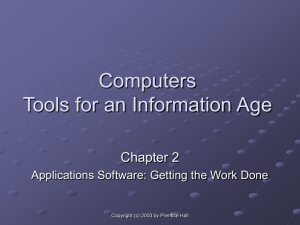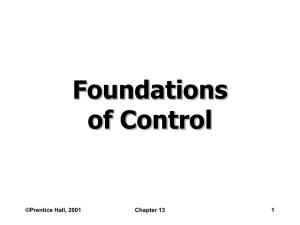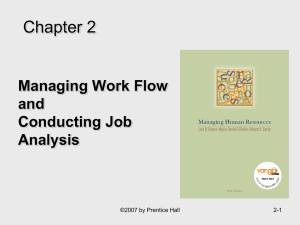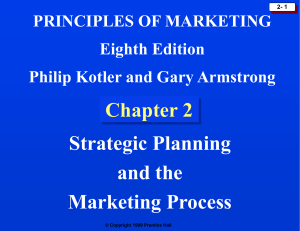Motivating and Rewarding Employees
advertisement
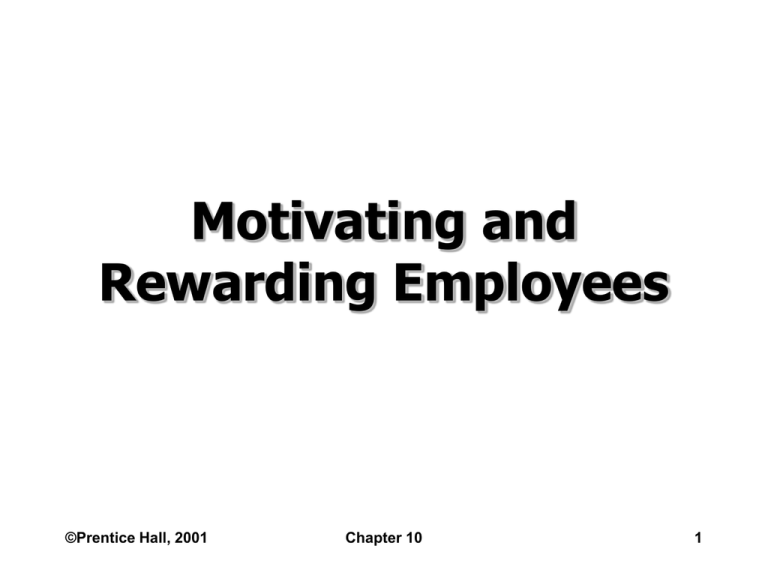
Motivating and Rewarding Employees ©Prentice Hall, 2001 Chapter 10 1 Learning Outcomes • Describe the motivation process • Define needs • Explain the hierarchy of needs theory • Compare Theory X and Theory Y • Examine the motivation-hygiene theory ©Prentice Hall, 2001 Chapter 10 2 Learning Outcomes • Examine motivation and equity theory • Explain expectancy theory • Design jobs to maximize performance • Discuss workforce diversity and motivation ©Prentice Hall, 2001 Chapter 10 3 The Motivation Process Unsatisfied Need Search Behavior Reduction of Tension Tension Drives ©Prentice Hall, 2001 Satisfied Need Chapter 10 4 Maslow’s Hierarchy of Needs Self Esteem Social Safety Physiological ©Prentice Hall, 2001 Chapter 10 5 Little Ambition Theory X Workers Dislike Work Avoid Responsibility Self-Directed Theory Y Workers Enjoy Work Accept Responsibility ©Prentice Hall, 2001 Chapter 10 6 Herzberg’s Two-Factor Theory Hygiene Factors • Quality of supervision • Salary and benefits • Company policies • Working conditions • Relations with others • Security and status High Job Dissatisfaction ©Prentice Hall, 2001 Motivators • Career advancement • Recognition • Work itself • Responsibility • Advancement •Growth 0 Chapter 10 Job Satisfaction High 7 Need for Achievement The Theory of Needs (nAch) Need for Power (nPow) Need for Affiliation David McClelland (nAff) ©Prentice Hall, 2001 Chapter 10 8 Equity Theory Employee’s Perception Ratio Comparison* Outcomes A < Inputs A Outcomes A Inputs A *Where Inequity (Under-Rewarded) Inputs B = Inputs A Outcomes A Outcomes B Outcomes B Equity Inputs B > Outcomes B Inequity (Over-Rewarded) Inputs B A is the employee, and B is a relevant other or referent. ©Prentice Hall, 2001 Chapter 10 9 Skill Variety Task Identity The Job Characteristics Model Task Significance Autonomy Feedback ©Prentice Hall, 2001 Chapter 10 10 Examples of High and Low Job Characteristics Characteristics Examples Skill Variety • High variety The owner-operator of a garage who does electrical repair, rebuilds engines, does body work, and interacts with customers • Low variety A bodyshop worker who sprays paint eight hours a day Task Identity • High identity A cabinetmaker who designs a piece of furniture, selects the wood, builds the object, and finishes it to perfection • Low identity A worker in a furniture factory who operates a lathe to make table legs Task Significance • High significance Nursing the sick in a hospital intensive-care unit • Low significance Sweeping hospital floors Autonomy • High autonomy A telephone installer who schedules his or her own work for the day, and decides on the best techniques for a particular installation • Low autonomy A telephone operator who must handle calls as they come according to a routine, highly specified procedure Feedback • High feedback An electronics factory worker who assembles a radio and then tests it to determine if it operates properly • Low feedback An electronics factory worker who assembles a radio and then routes it to a quality control inspector who tests and adjusts it ©Prentice Hall, 2001 Chapter 10 11 The Job Characteristics Model Core Job Dimensions Skill variety Task identify Task significance Critical Psychological States Experienced meaningfulness of the work Autonomy Experienced responsibility for outcomes of the work Feedback Knowledge of the actual results of the work activities Personal and Work Outcomes High internal work motivation High-quality work performance High satisfaction with the work Low absenteeism and turnover Employee Growth Need Strength ©Prentice Hall, 2001 Chapter 10 12 The Motivating Potential Score Motivating = Potential Score (MPS) Skill + Task + Task X Autonomy X Feedback Variety Identity Significance High MPS Increases ©Prentice Hall, 2001 3 Motivation Performance Satisfaction Chapter 10 and Decreases Absence Turnover 13 Expectancy Theory Individual Effort 1 Individual Performance 2 Organizational Rewards 3 1. Effort-performance relationship 2. Performance-rewards relationship Individual Goals 3. Rewards-personal goals relationship ©Prentice Hall, 2001 Chapter 10 14 An Integrative Model of Motivation High nAch Ability Opportunity Individual Effort Performance Appraisal Criteria Individual Performance Performance Appraisal System ©Prentice Hall, 2001 Equity Comparison O O IA IB Organization Rewards Reinforcement Goals Direct Behavior Personal Goals Dominant Needs 15 Contemporary Motivation Issues • Workforce diversity • Pay-for-performance • Minimum-wage workers • Professional employees • Technical workers ©Prentice Hall, 2001 Chapter 10 16 Flexible Work Options Compressed Workweek Job Sharing Flextime Telecommuting ©Prentice Hall, 2001 Chapter 10 17
